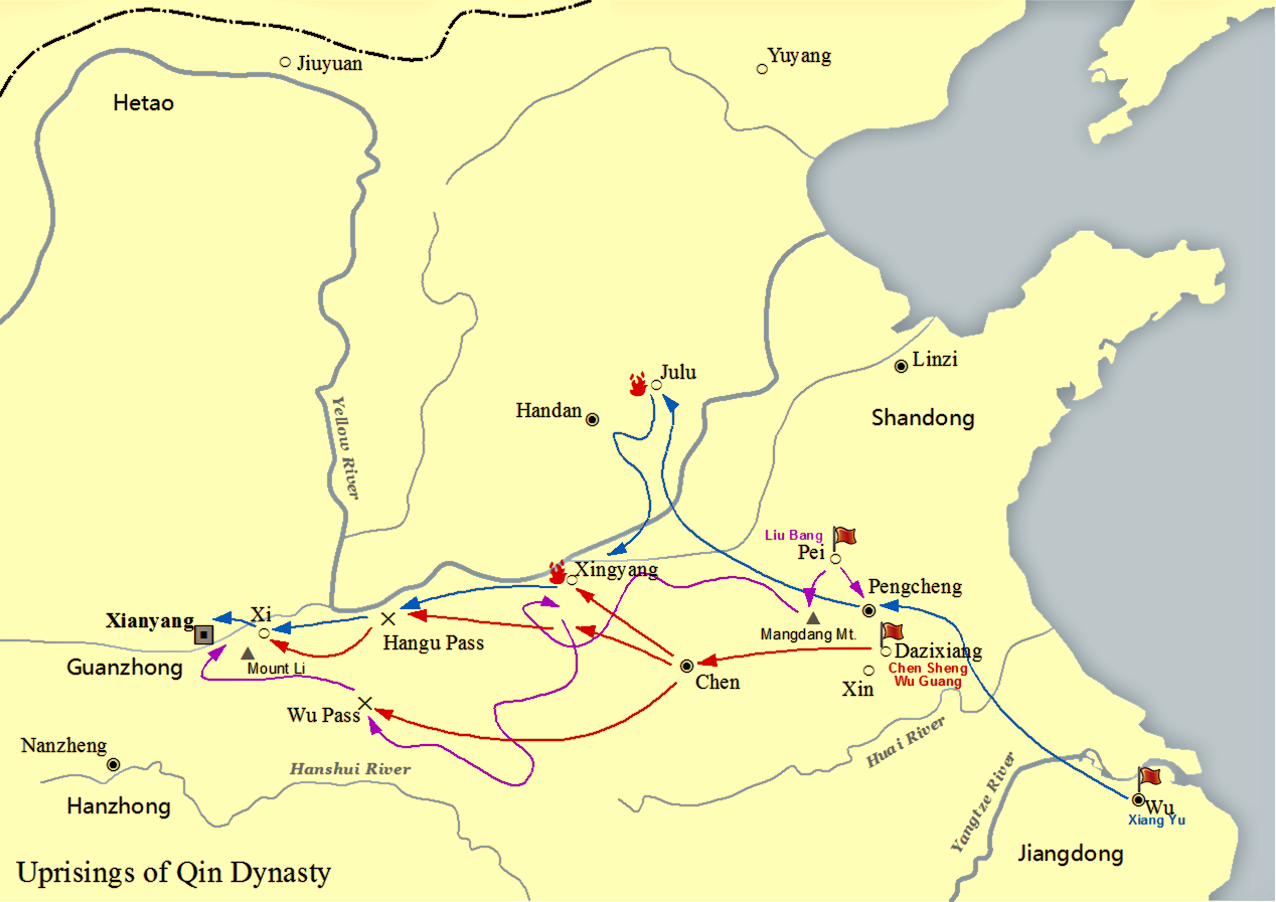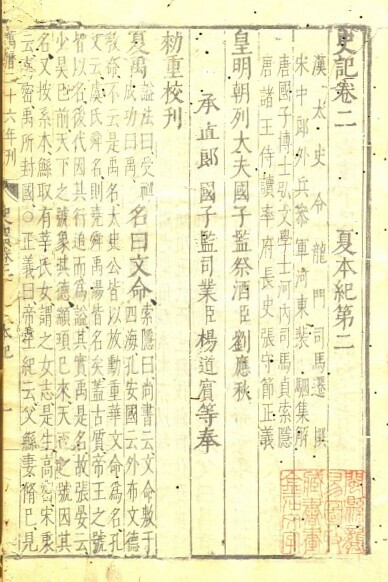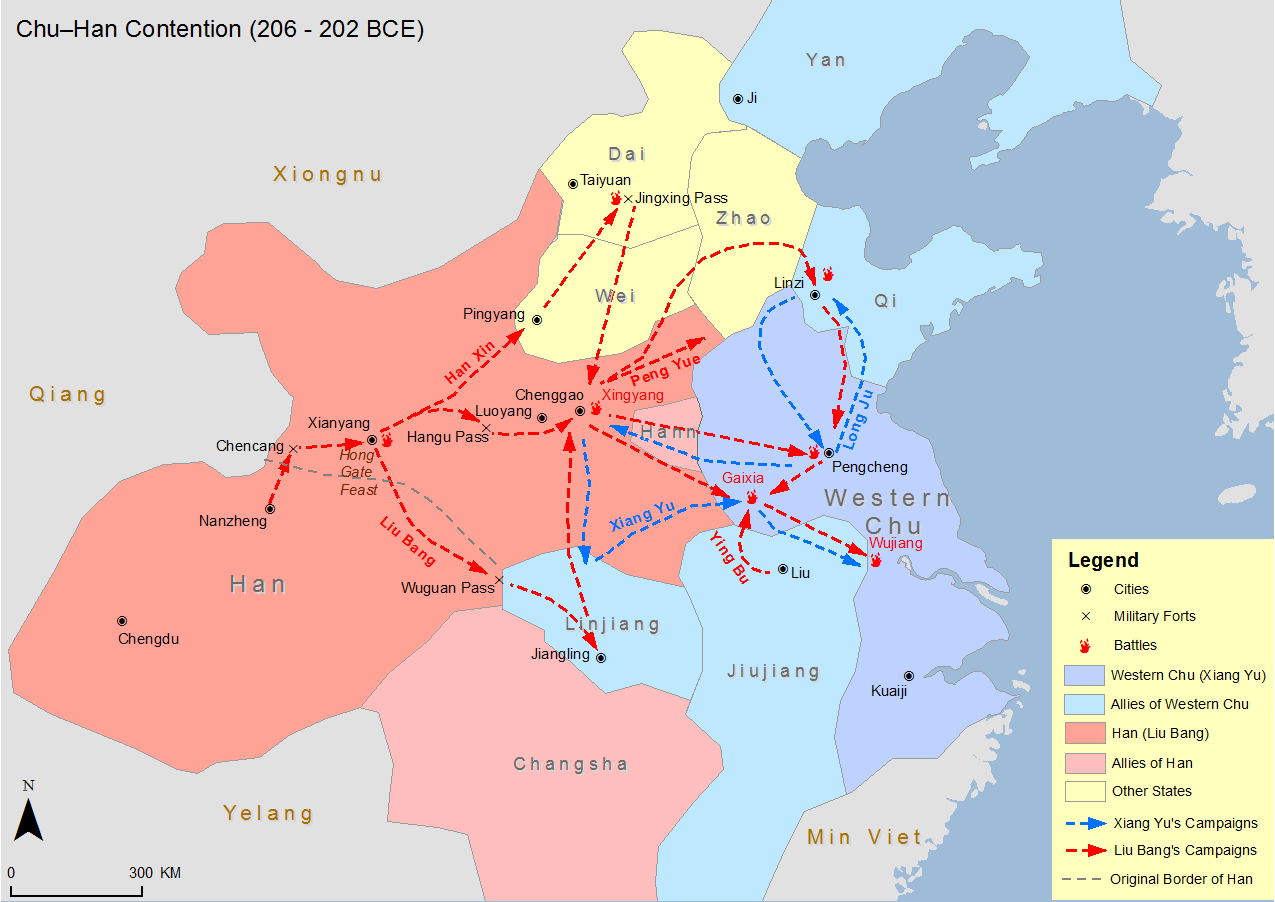|
Chen Sheng And Wu Guang Uprising
The Chen Sheng and Wu Guang uprising (), August 209 B.C.– January 208 B.C., was the first uprising against the Qin dynasty following the death of Qin Shi Huang. Led by Chen Sheng and Wu Guang, the uprising was unsuccessful. Name It is also called the Dazexiang uprising () as the uprising started in Dazexiang (大泽乡), which translates into "Big Swamp Village". History Chen Sheng and Wu Guang were both army officers who were ordered to lead their bands of commoner soldiers north to participate in the defense of Yuyang ( zh, s=渔阳, t=漁陽). However, they were stopped halfway in present-day Anhui province by flooding from a severe rainstorm. The harsh Qin laws mandated execution for those who showed up late for government jobs, regardless of the nature of the delay. Figuring that they would rather fight than accept execution, Chen and Wu organized a band of 900 villagers to rebel against the government. The current emperor, Huhai, had killed his brother Fusu, who was ... [...More Info...] [...Related Items...] OR: [Wikipedia] [Google] [Baidu] |
Henan
Henan; alternatively Honan is a province in Central China. Henan is home to many heritage sites, including Yinxu, the ruins of the final capital of the Shang dynasty () and the Shaolin Temple. Four of the historical capitals of China, Luoyang, Anyang, Kaifeng and Zhengzhou, are in Henan. While the province's name means 'south of the river', approximately a quarter of the province lies north of the Yellow River. With an area of , Henan covers a large part of the fertile and densely populated North China Plain. Its neighboring provinces are Shaanxi, Shanxi, Hebei, Shandong, Anhui, and Hubei. Henan is China's third-most populous province and the most populous among inland provinces, with a population of over 99 million as of 2020. It is also the world's seventh-most populous administrative division; if it were a country by itself, Henan would be the 17th-most populous in the world, behind Egypt and Vietnam. People from Henan often suffer from regional discrimination ... [...More Info...] [...Related Items...] OR: [Wikipedia] [Google] [Baidu] |
Liu Bang
Emperor Gaozu of Han (2561 June 195 BC), also known by his given name Liu Bang, was the founder and first emperor of the Han dynasty, reigning from 202 to 195 BC. He is considered by traditional Chinese historiography to be one of the greatest emperors in history, credited with establishing the first Pax Sinica, one of China's longest golden ages. Liu Bang was among the few dynastic founders to have been born in a peasant family. He initially entered the Qin dynasty bureaucracy as a minor law enforcement officer in his home town in Pei County, within the conquered state of Chu. During the political chaos following the death of Qin Shi Huang, who had been the first emperor in Chinese history, Liu Bang renounced his civil service position and became a rebel leader, taking up arms against the Qin dynasty. He outmanoeuvred rival rebel leader Xiang Yu to invade the Qin heartland and forced the surrender of the Qin ruler Ziying in 206 BC. After the fall of ... [...More Info...] [...Related Items...] OR: [Wikipedia] [Google] [Baidu] |
Peasant Revolts
This is a chronological list of revolts organized by peasants. Background The history of peasant wars spans over two thousand years. A variety of factors fueled the emergence of the peasant revolt phenomenon, including: * Tax resistance * Social inequality * Religious war * National liberation * Resistance against serfdom * Land reform * External factors such as plague and famine Later peasant revolts such as the Telangana Rebellion were also influenced by agrarian socialist ideologies such as Maoism. The majority of peasant rebellions ended prematurely and were unsuccessful. Peasants suffered from limited funding and lacked the training and organisational capabilities of professional armies. Chronological list The list gives the name, the date, the peasant allies and enemies, and the result of these conflicts following this legend: : : : : See also * Servile Wars * Peasant movement * Popular revolts in late-medieval Europe * Maoism * United Nations Declaration ... [...More Info...] [...Related Items...] OR: [Wikipedia] [Google] [Baidu] |
Military History Of The Qin Dynasty
A military, also known collectively as armed forces, is a heavily armed, highly organized force primarily intended for warfare. Militaries are typically authorized and maintained by a sovereign state, with their members identifiable by a distinct military uniform. They may consist of one or more military branches such as an army, navy, air force, space force, marines, or coast guard. The main task of a military is usually defined as defence of their state and its interests against external armed threats. In broad usage, the terms "armed forces" and "military" are often synonymous, although in technical usage a distinction is sometimes made in which a country's armed forces may include other paramilitary forces such as armed police. Beyond warfare, the military may be employed in additional sanctioned and non-sanctioned functions within the state, including internal security threats, crowd control, promotion of political agendas, emergency services and reconstruction ... [...More Info...] [...Related Items...] OR: [Wikipedia] [Google] [Baidu] |
209 BC
__NOTOC__ Year 209 BC was a year of the pre-Julian Roman calendar. At the time it was known as the Year of the Consulship of Verrucosus and Flaccus (or, less frequently, year 545 ''Ab urbe condita''). The denomination 209 BC for this year has been used since the early medieval period, when the Anno Domini calendar era became the prevalent method in Europe for naming years. Events By place Roman Republic * The Romans under Quintus Fabius Maximus Verrucosus capture Tarentum (modern Taranto), which the Carthaginian general Hannibal has held for three years. * The Battle of Canusium is fought between Hannibal's Carthaginian army and a Roman force led by Marcus Claudius Marcellus. The battle is indecisive. * From his headquarters at Tarraco (Tarragona), Publius Cornelius Scipio, the Roman commander in Spain, launches a combined military and naval assault on the Carthaginian headquarters at Carthago Nova (modern-day Cartagena). He successfully besieges and captures the city ... [...More Info...] [...Related Items...] OR: [Wikipedia] [Google] [Baidu] |
200s BC Conflicts
S, or s, is the nineteenth letter of the Latin alphabet, used in the English alphabet, the alphabets of other western European languages and other latin alphabets worldwide. Its name in English is ''ess'' (pronounced ), plural ''esses''. History Northwest Semitic šîn represented a voiceless postalveolar fricative (as in 'ip'). It originated most likely as a pictogram of a tooth () and represented the phoneme via the acrophonic principle. Ancient Greek did not have a "sh" phoneme, so the derived Greek letter Sigma () came to represent the voiceless alveolar sibilant . While the letter shape Σ continues Phoenician ''šîn'', its name ''sigma'' is taken from the letter ''Samekh'', while the shape and position of ''samekh'' but name of ''šîn'' is continued in the '' xi''. Within Greek, the name of ''sigma'' was influenced by its association with the Greek word (earlier ), "to hiss". The original name of the letter "Sigma" may have been ''san'', but due to the earl ... [...More Info...] [...Related Items...] OR: [Wikipedia] [Google] [Baidu] |
Sima Qian
Sima Qian () was a Chinese historian during the early Han dynasty. He is considered the father of Chinese historiography for the ''Shiji'' (sometimes translated into English as ''Records of the Grand Historian''), a general history of China covering more than two thousand years from the rise of the legendary Yellow Emperor and formation of the first Chinese polity to the reign of Emperor Wu of Han, during which Sima wrote. As the first universal history of the world as it was known to the ancient Chinese, the ''Shiji'' served as a model for official histories for subsequent dynasties across the Sinosphere until the 20th century. Sima Qian's father, Sima Tan, first conceived of the ambitious project of writing a complete history of China, but had completed only some preparatory sketches at the time of his death. After inheriting his father's position as court historian in the imperial court, he was determined to fulfill his father's dying wish of composing and putting together th ... [...More Info...] [...Related Items...] OR: [Wikipedia] [Google] [Baidu] |
Records Of The Grand Historian
The ''Shiji'', also known as ''Records of the Grand Historian'' or ''The Grand Scribe's Records'', is a Chinese historical text that is the first of the Twenty-Four Histories of imperial China. It was written during the late 2nd and early 1st centuries BC by the Han dynasty historian Sima Qian, building upon work begun by his father Sima Tan. The work covers a 2,500-year period from the age of the legendary Yellow Emperor to the reign of Emperor Wu of Han in the author's own time, and describes the world as it was known to the Chinese of the Western Han dynasty. The ''Shiji'' has been called a "foundational text in Chinese civilization". After Confucius and Qin Shi Huang, "Sima Qian was one of the creators of Imperial China, not least because by providing definitive biographies, he virtually created the two earlier figures." The ''Shiji'' set the model for all subsequent dynastic histories of China. In contrast to Western historiographical conventions, the ''Shiji'' does no ... [...More Info...] [...Related Items...] OR: [Wikipedia] [Google] [Baidu] |
Pinyin
Hanyu Pinyin, or simply pinyin, officially the Chinese Phonetic Alphabet, is the most common romanization system for Standard Chinese. ''Hanyu'' () literally means 'Han Chinese, Han language'—that is, the Chinese language—while ''pinyin'' literally means 'spelled sounds'. Pinyin is the official romanization system used in China, Singapore, Taiwan, and by the United Nations. Its use has become common when transliterating Standard Chinese mostly regardless of region, though it is less ubiquitous in Taiwan. It is used to teach Standard Chinese, normally written with Chinese characters, to students in mainland China and Singapore. Pinyin is also used by various Chinese input method, input methods on computers and to lexicographic ordering, categorize entries in some Chinese dictionaries. In pinyin, each Chinese syllable is spelled in terms of an optional initial (linguistics), initial and a final (linguistics), final, each of which is represented by one or more letters. Initi ... [...More Info...] [...Related Items...] OR: [Wikipedia] [Google] [Baidu] |
Xiang Yu
Xiang Yu (), born Xiang Ji, was a Chinese warlord who founded and led the short-lived ancient Chinese states, kingdom-state of Western Chu during the interregnum period between the Qin dynasty, Qin and Han dynasty, Han dynasties of China, dynasties known as the Chu–Han Contention (206–202 BC). A nobleman of the former state of Chu, Xiang Yu rebelled against the Qin dynasty under the command of his uncle Xiang Liang, and was granted the title of "Duke of Lu" () by Emperor Yi of Chu, King Huai II of the restoring Chu state in 208 BC. The following year, he led an outnumbered Chu army to victory at the Battle of Julu against the Qin armies led by Zhang Han (Qin dynasty), Zhang Han. After the fall of Qin, Xiang Yu divided the country into a federacy of Eighteen Kingdoms, among which he was self-titled as the "Hegemon-King of Western Chu" () and ruled a vast region spanning central and eastern China, with Pengcheng as his capital. Although a formidable warrior and milita ... [...More Info...] [...Related Items...] OR: [Wikipedia] [Google] [Baidu] |
Chu (state)
Chu (, Old Chinese: ''*s-r̥aʔ'') was an Ancient Chinese states, ancient Chinese state during the Zhou dynasty. Their first ruler was King Wu of Chu in the early 8th century BC. Chu was located in the south of the Zhou heartland and lasted during the Spring and Autumn period. At the end of the Warring States period it was annexed by the Qin (state), Qin in 223 BC during the Qin's wars of unification. Also known as Jing () and Jingchu (), Chu included most of the present-day provinces of Hubei and Hunan, along with parts of Chongqing, Guizhou, Henan, Anhui, Jiangxi, Jiangsu, Zhejiang, and Shanghai. For more than 400 years, the Chu capital Danyang (Chu), Danyang was located at the junction of the Dan River (China), Dan and Xi Rivers near present-day Xichuan County, Henan, but later moved to Ying (Chu), Ying. The house of Chu originally bore the Chinese surname#Xing, ancestral temple surname Nai ( OC: /*rneːlʔ/) which was later written as Mi (surname), Mi ( OC: /*meʔ/). Th ... [...More Info...] [...Related Items...] OR: [Wikipedia] [Google] [Baidu] |
China
China, officially the People's Republic of China (PRC), is a country in East Asia. With population of China, a population exceeding 1.4 billion, it is the list of countries by population (United Nations), second-most populous country after India, representing 17.4% of the world population. China spans the equivalent of five time zones and Borders of China, borders fourteen countries by land across an area of nearly , making it the list of countries and dependencies by area, third-largest country by land area. The country is divided into 33 Province-level divisions of China, province-level divisions: 22 provinces of China, provinces, 5 autonomous regions of China, autonomous regions, 4 direct-administered municipalities of China, municipalities, and 2 semi-autonomous special administrative regions. Beijing is the country's capital, while Shanghai is List of cities in China by population, its most populous city by urban area and largest financial center. Considered one of six ... [...More Info...] [...Related Items...] OR: [Wikipedia] [Google] [Baidu] |








